
Anthony or Antony the Great, was a Christian monk from Egypt, revered since his death as a saint. He is distinguished from other saints named Anthony such as Anthony of Padua, by various epithets of his own: Saint Anthony, Anthony of Egypt, Antony the Abbot,Anthony of the Desert,Anthony the Anchorite, and Anthony of Thebes. For his importance among the Desert Fathers and to all later Christian monasticism, he is also known as the Father of All Monks. His feast day is celebrated on 17 January among the Orthodox and Catholic churches and on Tobi 22 in the Coptic calendar.
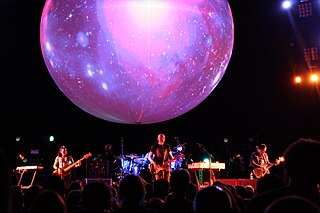
The Smashing Pumpkins are an American alternative rock band from Chicago. Formed in 1988 by frontman Billy Corgan, D'arcy Wretzky (bass), James Iha (guitar), and Jimmy Chamberlin (drums), the band has undergone many line-up changes. The current lineup features Corgan, Chamberlin, Iha and guitarist Jeff Schroeder.

The Bedouin or Bedu are an ethnic group of nomadic Arabs who have historically inhabited the desert regions in North Africa, the Arabian Peninsula, Upper Mesopotamia and the Levant. The English word bedouin comes from the Arabic badawī, which means "desert dweller", and is traditionally contrasted with ḥāḍir, the term for sedentary people. Bedouin territory stretches from the vast deserts of North Africa to the rocky sands of the Middle East. They are traditionally divided into tribes, or clans, and historically share a common culture of herding camels and goats. The vast majority of Bedouin adhere to Islam, although there are some fewer numbers of Arab Christian Bedouins present in the Fertile Crescent.

Thebes, known to the ancient Egyptians as Waset, was an ancient Egyptian city located along the Nile about 800 kilometers (500 mi) south of the Mediterranean. Its ruins lie within the modern Egyptian city of Luxor. Thebes was the main city of the fourth Upper Egyptian nome and was the capital of Egypt for long periods during the Middle Kingdom and New Kingdom eras. It was close to Nubia and the Eastern Desert, with its valuable mineral resources and trade routes. It was a cult center and the most venerated city during many periods of ancient Egyptian history. The site of Thebes includes areas on both the eastern bank of the Nile, where the temples of Karnak and Luxor stand and where the city proper was situated; and the western bank, where a necropolis of large private and royal cemeteries and funerary complexes can be found.
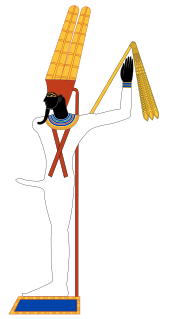
Min is an ancient Egyptian god whose cult originated in the predynastic period. He was represented in many different forms, but was most often represented in male human form, shown with an erect penis which he holds in his left hand and an upheld right arm holding a flail.
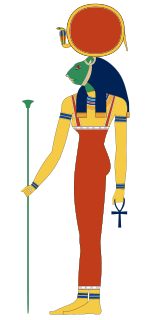
In Egyptian mythology, Sekhmet, also spelled Sakhmet, Sekhet, Sakhet, or Scheme, among other spellings), is a warrior goddess as well as goddess of healing. She is depicted as a lioness. She was seen as the protector of the pharaohs and led them in warfare. Upon death, Sekhmet continued to protect them, bearing them to the afterlife.
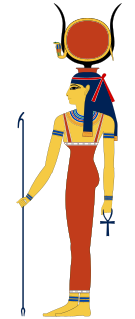
Hathor was a major goddess in ancient Egyptian religion who played a wide variety of roles. As a sky deity, she was the mother or consort of the sky god Horus and the sun god Ra, both of whom were connected with kingship, and thus she was the symbolic mother of their earthly representatives, the pharaohs. She was one of several goddesses who acted as the Eye of Ra, Ra's feminine counterpart, and in this form she had a vengeful aspect that protected him from his enemies. Her beneficent side represented music, dance, joy, love, sexuality and maternal care, and she acted as the consort of several male deities and the mother of their sons. These two aspects of the goddess exemplified the Egyptian conception of femininity. Hathor crossed boundaries between worlds, helping deceased souls in the transition to the afterlife.

The Siwa Oasis is an urban oasis in Egypt between the Qattara Depression and the Great Sand Sea in the Western Desert, 50 km (30 mi) east of the Libyan border, and 560 km (348 mi) from Cairo. About 80 km (50 mi) in length and 20 km (12 mi) wide, Siwa Oasis is one of Egypt's most isolated settlements with about 33,000 people, mostly Berbers, who developed a unique and isolated desert culture and a distinct dialect and language different than all other dialects called Siwi, they are also fluent in the Egyptian dialect of Arabic which is called "Masry" meaning Egyptian.

The Sahara is a desert located on the African continent. With an area of 9,200,000 square kilometres (3,600,000 sq mi), it is the largest hot desert in the world and the third largest desert overall after Antarctica and the Arctic. The name 'Sahara' is derived from the Arabic word for "desert", ṣaḥra.
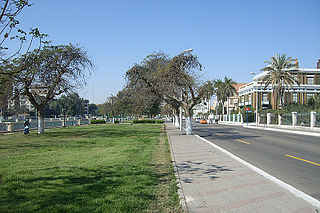
Ismailia is a city in north-eastern Egypt. Known in Egypt as "The City of Beauty and Enchantment", Ismailia is situated on the west bank of the Suez Canal, it is the capital of the Ismailia Governorate. The city has a population of 366,669 as of 2012. It is located approximately halfway between Port Said to the north and Suez to the south. The Canal widens at that point to include Lake Timsah, one of the Bitter Lakes linked by the Canal.

Amenhotep I, Amenôthes I, or Amenophis I, (,) from Ancient Greek Ἀμένωφις, additionally King Zeserkere, was the second Pharaoh of the 18th dynasty of Egypt. His reign is generally dated from 1526 to 1506 BC. He was a son of Ahmose I and Ahmose-Nefertari, but had at least two elder brothers, Ahmose-ankh and Ahmose Sapair, and was not expected to inherit the throne. However, sometime in the eight years between Ahmose I's 17th regnal year and his death, his heir apparent died and Amenhotep became crown prince. He then acceded to the throne and ruled for about 21 years. Although his reign is poorly documented, it is possible to piece together a basic history from available evidence. He inherited the kingdom formed by his father's military conquests and maintained dominance over Nubia and the Nile Delta but probably did not attempt to maintain Egyptian power in the Levant. He continued the rebuilding of temples in Upper Egypt and revolutionized mortuary complex design by separating his tomb from his mortuary temple, setting a trend in royal funerary monuments which would persist throughout the New Kingdom. After his death, he was deified as a patron god of Deir el-Medina.

Cenobiticmonasticism is a monastic tradition that stresses community life. Often in the West the community belongs to a religious order, and the life of the cenobitic monk is regulated by a religious rule, a collection of precepts. The older style of monasticism, to live as a hermit, is called eremitic. A third form of monasticism, found primarily in Eastern Christianity, is the skete.

Mary of Egypt is revered as the patron saint of penitents, most particularly in the Catholic Church, Eastern Orthodox Churches, and Oriental Orthodox Churches.

The Eastern Desert is the part of the Sahara desert that is located east of the Nile river, between the river and the Red Sea. It extends from Egypt in the north to Eritrea in the south, and also comprises parts of Sudan and Ethiopia. The Eastern Desert is also known as the Red Sea Hills, the Arabian Desert, and the Arabian Mountain Ranges because to the east it is bordered by the Red Sea and because it was originally inhabited by Arabs in Pre-Islamic Egypt, respectively.

The Farafra depression is a 980 km2 (380 sq mi) geological depression, the second biggest by size in Western Egypt and the smallest by population, near latitude 27.06° north and longitude 27.97° east. It is in the large Western Desert of Egypt, approximately midway between Dakhla and Bahariya oases.

Legacy of the Catacombs is a compilation album by the technical death metal band Nile. It was released on July 10, 2007. It was called "a collection of band and fan favorites, as well as a bonus DVD containing all of their studio videos".
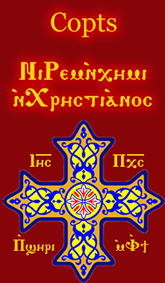
Coptic Monasticism is claimed to be the original form of Monasticism as St. Anthony of Egypt became the first one to be called "monk" and he was the first to established a Christian monastery which is now known as the Monastery of Saint Anthony in the Red Sea area. St. Anthony's Monastery is now the oldest monastery in the world.
The gens Antia was a plebeian family at Roman, which seems to have been of considerable antiquity. The first member of the gens to come to prominence was Spurius Antius, one of four ambassadors sent to Lars Tolumnius, the king of Veii in 438 BC. The family was not especially important during the Republic, but continued into the 3rd century, obtaining the consulship in AD 94 and 105.
Antius may refer to a number of people or things:

The Western Desert of Egypt is an area of the Sahara which lies west of the river Nile, up to the Libyan border, and south from the Mediterranean sea to the border with Sudan. It is named in contrast to the Eastern Desert which extends east from the Nile to Red Sea. The Western Desert is mostly rocky desert, though an area of sandy desert, known as the Great Sand Sea, lies to the west against the Libyan border. The desert covers an area of 680,650 km2 (262,800 sq mi) which is two-thirds of the land area of the country. Its highest elevation is 1,000 m (3,300 ft) in the Gilf Kebir plateau to the far south-west of the country, on the Egypt-Sudan-Libya border. The Western Desert is barren and uninhabited save for a chain of oases which extend in an arc from Siwa, in the north-west, to Kharga in the south. It has been the scene of conflict in modern times, particularly during the Second World War.

















